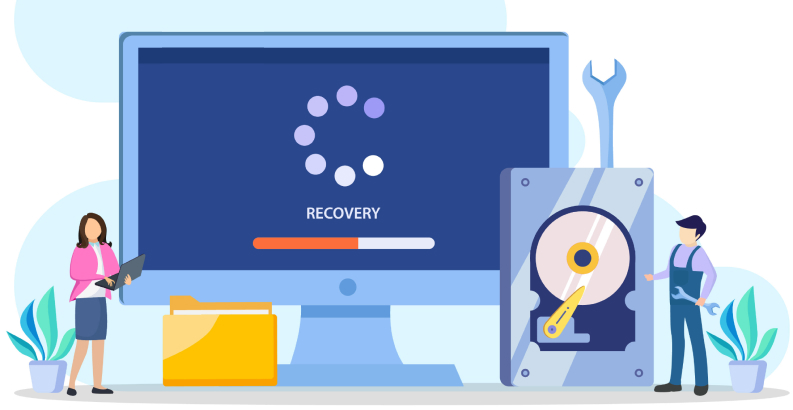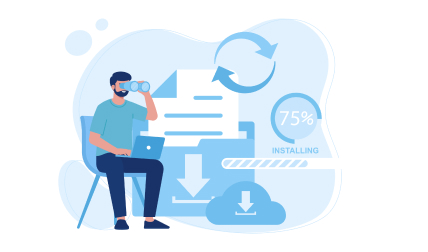Safeguard your digital assets and avoid disruptions or downtime with Homefield IT Disaster Recovery as a Service (DRaaS) Solutions.

What is disaster recovery?
Disaster recovery is a plan to regain access and functionality of your IT systems and networks after a catastrophic event. Whether you’re hit by natural disasters like earthquakes and floods, or cyber-attacks, hardware failures, or even human error, disaster recovery will ensure critical data can be recovered quickly to minimize the impact on your business operations.
What are disaster recovery services?
What would you do if your entire network went down? You can’t access your digital assets on site or in the cloud…
Creating a disaster recovery process is complex, but having a disaster recovery solution in place is the safety net your business needs to weather the storm of unforeseen disasters and ensure business continuity.
And that means having more than just a cloud backup of your files and data.
As experienced disaster recovery experts, we get you back up and running as quickly as possible. With us as your trusted IT partner, you’re not only protecting critical data, but safeguarding the future of your business.
With our disaster recovery solutions, we won’t let a disaster stop your business.
IT network disaster recovery as a service: a lifesaver for businesses
You don’t want to be left vulnerable when a disaster strikes.
Think of a solid disaster recovery plan like an insurance policy for your digital assets. It ensures that, in the event of a disaster, your business can continue its operations with minimal disruption and data loss.
Tailored solutions for your business
Our IT network disaster recovery services are all customizable. We assess the unique needs and vulnerabilities of your business to create a tailored continuity plan. Meaning every critical aspect of your network is covered, from data backups to failover systems.
Do you need cloud disaster recovery solutions? A secondary data center? We are experts at optimizing disaster recovery procedures, whatever you need, we’ve got you covered.
Our disaster recovery services typically include:
Backup and restore
This involves backing up your data to an off-site location so it can be restored in the event of a disaster.
Disaster recovery planning
This involves creating a plan for how you’ll recover from a disaster, including identifying risks, developing mitigation strategies, and testing the plan.
Business continuity planning
This involves creating a plan for how to keep your business running in the event of a disaster, even if it means operating in a temporary location or with limited resources.

Rapid response and recovery
In the face of a disaster, time is of the essence. We have the expertise and resources to respond swiftly. We employ advanced technologies and strategies to restore your operations promptly, minimizing downtime and revenue loss.

Ensuring data integrity
Data is the lifeblood of your organization. With our disaster recovery services, your data protection is a top priority. Through regular backups and redundancy measures, we guarantee your valuable data remains intact and accessible and there is no data loss.
Why Homefield IT for your disaster recovery service provider
Expertise and experience
We have a proven track record in disaster recovery. Having a plan is one thing, but being confident that plan will work when it’s needed is another. We’ll create and test your disaster recovery plan so you’re confident your business is prepared and protected for any disaster.
Comprehensive services
We offer a full range of disaster recovery solutions, including data backup, system restoration, and continuity planning. From physical servers to cloud services, whatever systems or processes you use, with our fully managed disaster recovery solution, we can help.
Scalability
We are adaptable to your business’s changing needs. As you grow, our disaster recovery solutions will grow with you.
Compliance and security measures
We adhere to industry standards and employ robust security protocols.
FAQ’s
How often should we update our disaster recovery processes plan?
Regular updates are crucial, because as your business evolves, so do its IT needs and vulnerabilities.
A good rule of thumb is to update your own disaster recovery plan at least once a year. However, you may need to update it more frequently if your organization experiences significant changes or if you face new risks.
Can disaster recovery services prevent cyber-attacks?
No, our disaster recovery services alone cannot prevent cyber-attacks. However, they can help to minimize the damage caused by a cyberattack and facilitate a faster recovery process.
Are cloud-based disaster recovery solutions secure?
If you use Homefield IT as your IT partner provider then yes, our disaster recovery solutions are secure. We employ robust encryption and security measures to safeguard your data.
Is disaster recovery only for large enterprises?
No, disaster recovery isn’t just for large enterprises. Disasters can happen to any organization, regardless of size. In fact, in our experience, small and medium-sized businesses are often more vulnerable to disasters than large enterprises because they often have fewer resources to invest in disaster recovery.
Some of the most common disaster recovery solutions include:
- Off-site backups: This involves backing up your data to an off-site location so that it can be restored in the event of a disaster.
- Disaster recovery as a service (DRaaS): This is a cloud-based solution that provides you with disaster recovery capabilities without the need to invest in and manage your own disaster recovery infrastructure.
- Disaster recovery plan: This is a vital document that outlines the steps your organization will take to recover from a disaster.
All of the solutions we provide are tailored to suit your specific business needs and budget.
How long does it typically take to recover after a disaster?
The recovery time depends on various factors, including the nature of the disaster and the complexity of your IT infrastructure.
For example, natural disasters, such as hurricanes, floods, and earthquakes, can cause widespread damage and take months or even years to recover from; whereas power outages might only take hours or a few days to recover from.
Larger organizations with more complex IT infrastructures tend to take longer to recover than smaller organizations with simpler infrastructures.
But… if you have access to the necessary resources, such as backup data, knowledgeable IT staff, and a well-prepared disaster recovery plan, you can significantly shorten your downtime and speed up the recovery process.
Contact us to get started
Find out how Homefield IT can turbocharge your technology.

